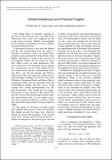| dc.contributor.author | Caballero, Ricardo J. | |
| dc.contributor.author | Krishnamurthy, Arvind | |
| dc.date.accessioned | 2011-03-02T18:30:04Z | |
| dc.date.available | 2011-03-02T18:30:04Z | |
| dc.date.issued | 2009-05 | |
| dc.identifier.issn | 0002-8282 | |
| dc.identifier.uri | http://hdl.handle.net/1721.1/61377 | |
| dc.description.abstract | The United States is currently engulfed in the most severe financial crisis since the Great
Depression. The crisis was triggered by the
crash in the real estate “bubble” and amplified
by the extreme concentration of risk in a highly
leveraged financial sector.
Conventional wisdom is that both the bubble
and the risk concentration were the result of
mistakes in regulatory policy: an expansionary
monetary policy during the boom period of the
bubble, and failure to reign in the practices of
unscrupulous lenders. In this paper we argue
that, while correct in some dimensions, this
story misses two key structural factors behind
the securitization process that supported the
real estate boom and the corresponding leverage.
First, over the last decade, the US has
experienced large and sustained capital inflows
from foreigners seeking US assets to store value
(Caballero, Emmanuel Farhi, and Pierre-Olivier
Gourinchas 2008). Second, especially after the
NASDAQ/tech bubble and bust, excess world
savings have looked predominantly for safe
debt investments. This should not be surprising
because a large amount of the capital flow
into the US has been from foreign central banks
and governments that are not expert investors
and are merely looking for a store of value
(Krishnamurthy and Annette Vissing-Jorgenson
2008).
In this paper we develop a stylized model
that captures the essence of this environment.
The model accounts for three facts observed
during the boom and bust phases of the current
crisis. First, during a period of good shocks—
which we interpret as the period up to the end
Global Imbalances and Financial Fragility
By Ricardo J. Caballero and Arvind Krishnamurthy*
of 2006—the growth in asset demand pushes up
asset prices and lowers risk premia and interest
rates. It is interesting to observe that the value
of risky assets rises despite the fact that the
increase in demand is for riskless assets. Second,
foreign demand for debt instruments increases
the equilibrium level of leverage of the domestic
financial sector. In order to accommodate this
demand, the US financial sector manufactures
debt claims out of all types of products, which is
the reason for the wave of securitization. Third,
if shocks turn negative—which we interpret as
the post-2006 period—the foreign demand now
turns toxic; bad shocks and high leverage lead to
an amplified downturn and rising risk premia.
In addition to highlighting the role of capital
flows in facilitating the securitization boom, our
analysis speaks to the broader issue of global
imbalances. Many of the concerns regarding
global imbalances derive from emerging markets’
experiences, where capital flows are often
speculative and a source of volatility, as emphasized
in the literature on sudden stops. Our
analysis shows that somewhat paradoxically, for
a core economy such as that of the US, the risk
in “excessive” capital inflows derives from the
opposite concern: capital flows into the country
are mostly nonspeculative and in search of
safety. As a result, the US sells riskless assets
to foreigners and in so doing raises the effective
leverage of its financial institutions. In other
words, as global imbalances rise, the US increas | en_US |
| dc.description.sponsorship | National Science Foundation (U.S.) | en_US |
| dc.language.iso | en_US | |
| dc.publisher | American Economic Association | en_US |
| dc.relation.isversionof | http://dx.doi.org/10.1257/aer.99.2.584 | en_US |
| dc.rights | Article is made available in accordance with the publisher's policy and may be subject to US copyright law. Please refer to the publisher's site for terms of use. | en_US |
| dc.source | MIT web domain | en_US |
| dc.title | Global Imbalances and Financial Fragility | en_US |
| dc.type | Article | en_US |
| dc.identifier.citation | Caballero, Ricardo J, and Arvind Krishnamurthy. “Global Imbalances and Financial Fragility.” American Economic Review 99.2 (2009): 584-588. © 2011 AEA. The American Economic Association | en_US |
| dc.contributor.department | Massachusetts Institute of Technology. Department of Economics | en_US |
| dc.contributor.approver | Caballero, Ricardo J. | |
| dc.contributor.mitauthor | Caballero, Ricardo J. | |
| dc.relation.journal | American Economic Review | en_US |
| dc.eprint.version | Final published version | en_US |
| dc.type.uri | http://purl.org/eprint/type/JournalArticle | en_US |
| eprint.status | http://purl.org/eprint/status/PeerReviewed | en_US |
| dspace.orderedauthors | Caballero, Ricardo J; Krishnamurthy, Arvind | en |
| dc.identifier.orcid | https://orcid.org/0000-0003-2760-451X | |
| mit.license | PUBLISHER_POLICY | en_US |
| mit.metadata.status | Complete | |
